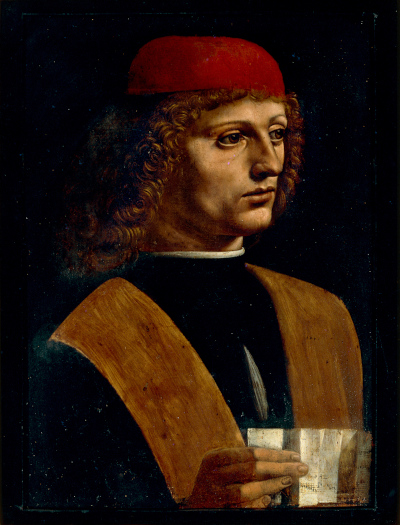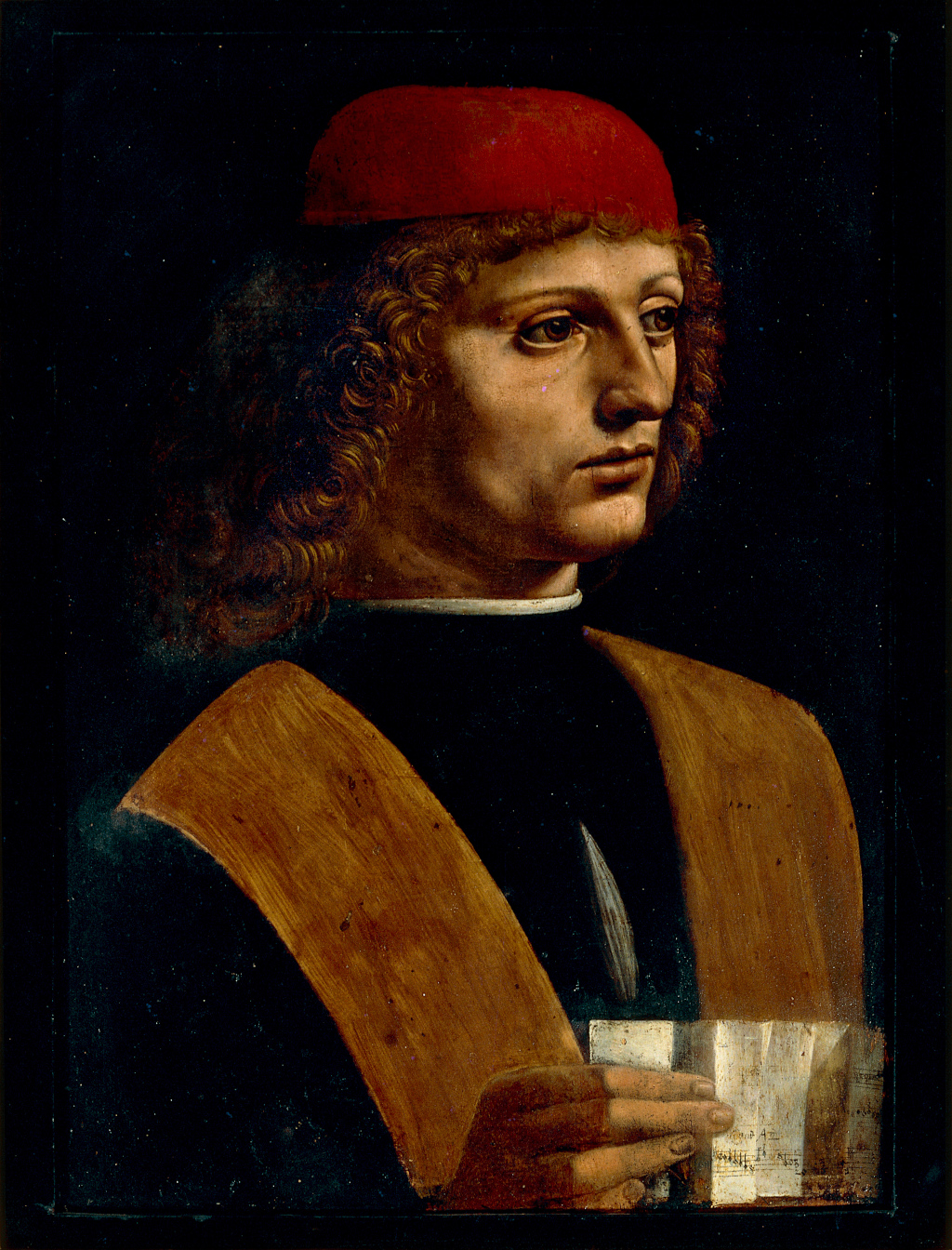Portrait of a Musician was completed by Leonardo da Vinci soon after he had relocated to the Italian city of Milan. He would soon become a court painter which helped him to quickly evolve his talents as a portrait painter of religious and secular figures.
The true indentity of the model in front of us here has never been determined, and it was only relatively recently that the musical connection was uncovered, after some paint was removed around the foot of the work in the early 20th century. This unveiled a sheet of music, with individual notes detailed alongside a short strip of text. Despite this revelation, the true identity of the musician has never been identified, but many possibities have been put forward in the 100 years or so that have passed since. Additional research has also found technical similarities between Portrait of a Musician and a number of other paintings confidently attributed to Leonardo da Vinci from around the same time, helping to strengthen the case that this is indeed also from his hand.
One of the greatest qualities of Leonardo the painter were his use of subtle tones in order to produce likelike finishes within his portraits, and elements of that can be found here too, though not perhaps to quite the same level as the likes of Lady with an Ermine or the later Mona Lisa. Indeed, a number of experts have come to the conclusion that Da Vinci only contributed parts of this work, and that some of his more respected assistants or colleagues would have worked on other elements. Renaissance artists regularly combined their efforts from within shared studios, and so this explanation seems entirely plausible.
Leonardo was mostly famous just as a painter for many centuries after his passing, and it has only in the past two centuries that historians have started to uncover his considerable achievements in other disciplines. As his drawings, inventions and theories have been collated, so we better understand how it all fits together within his overall career, with each discipline feeding into each other. His paintings would be influenced by his knowledge of maths and science, for example, as well as his considerable talents as a draughtsman and regular practice within that craft, particularly in terms of anatomical portraiture.
Within this article we examine the history behind Leonardo da Vinci's Portrait of a Musician and also discuss its technical qualities and issues. We drill down deeper into where it fits within the artist's overall career, and compare it with some of his other portrait paintings from around this same period. We also touch of where the painting can be found today, for those looking to view it in person, and the journey that it took in order to arrive there. Finally, a larger image of the painting is included at the very bottom of the page, allowing us all to see more of the detail added by Da Vinci, and potentially his assistants, all those years ago.
Table of Contents
- Introduction
- Description
- Analysis and Critical Reception
- Timeline
- Location
- Identity of the Model
- Attribution
- Size and Medium
- Large Image of Portrait of a Musician
- References
Introduction
Portrait of a Musician represents a period in Da Vinci's career when he produced a number of secular portraits of local Italian figures. Many of these were of women, such as his portrait of Ginevra de' Benci, but in this case he chose to portray a young man who would later be identified as a musician, once some over painting had been removed from the lower part of the work. Many mysteries still persist around this piece, but its date and attribution have been agreed upon by the majority of scholars. This painting, which remains today at the Pinacoteca Ambrosiana, Milan, is in amongst the best condition of any of the artist's paintings from across his entire career, and below we examine the piece in detail.
Description
A young musician is pictured from the waist up in front of a darkened background. The figure faces off to the right hand side and appears to be staring at something outside the scope of the painting. He wears a red cap, with long, curly hair appearing from beneath and hanging down both sides of his face. His facial features are fairly angular, with a long, prominent nose. His lips are pursed together and his eyes fixated elsewhere, giving him a somewhat serious expression. It is this head section that was entirely finished, and is also believed to have been carried out entirely by Leonardo. His smart but modest clothing has been identified as a black doublet with a brown stole, which was typical fashion for the period.
The music sheet is detailed, with individual notes visible. His fingers hold it up for the viewer, with some cropping of the wood having been made at the bottom of the painting. Whilst elements of the work remained unfinished, Portrait of a Musician is actually regarded as being in a better condition than most of Leonardo da Vinci's attributed paintings. There are only a few signs of wear or alterations from after his lifetime, and any restoration work has been relatively successful. Its inclusion in Milan's Pinacoteca Ambrosiana since the 17th century, rather than being relocated many times over, is perhaps why it has lasted so well over the past five or more centuries.
Analysis and Critical Reception
Whilst Portrait of a Musician bears many similarities to related artworks such as Lady with an Ermine and La Belle Ferronniere, most scholars do not believe it is as impressive an artwork. Some have labelled the model's face as wooden, and also criticised specific parts of it, such as the left side of his face and his upper lip. Leonardo was respected for his innovative postures, where face and body may be turned in slightly different angles, but in this piece we do not see that same technique in action. That said, it is still a highly respectable artwork in its own right, and perhaps suffers from the qualities of other Da Vinci paintings from this period, rather than its own shortcomings. It also remains in a better condition than most of his other works in oils and tempera, remaining as it does in Milan, where it was first conceived.
Timeline
This unfinished painting is dated to around 1483–1487, at which point the artist would have been in his early thirties. Leonardo is likely to have completed his initial work on the Virgin of the Rocks at this point, as well as Adoration of the Magi a few years earlier. In the years that followed on after Portrait of a Musician, we find a further series of small portraits, such as Lady with an Ermine, Litta Madonna and La Belle Ferronniere. Da Vinci had made a fresh start in Milan in around 1483, at this relocation would bring new ideas and opportunities to his door, as well as helping him to evolve further as an artist. Previously he had been very much connected to Verrocchio and other members of the studio in which he served as an apprentice in Florence.
Location
Leonardo da Vinci's Portrait of a Musician can be found at the Pinacoteca Ambrosiana in the Italian city of Milan. It has remained there since around the 1670s and the artist would have been living in Milan at the time that he produced this piece. It was Cardinal Borromeo who set up this important institution around half a century earlier, with its display mainly consisting of items that he previously held in a private collection. Visitors here will also see items from other parts of Leonardo da Vinci's career, including valuable manuscripts and some of his inventive designs, such as a sketch of a crossbow.
Identity of the Model
It was not until the early 20th century that the musical aspect to this painting was discovered. Some restoration work removed paint which had been added after Da Vinci's own contribution and what was left at the bottom of the canvas was the model's hand holding a sheet of music. Instantly, it became clear as to the role of this model, and this set off a debate over who this musician might have been. Typically in traditional western art, such as the Renaissance or Baroque eras, clues as to a model's form of employment would be added in this manner. That said, it is relatively rare within Da Vinci's own oeuvre, partly because of the nature of the portraits that he produced.
Scholars immediately researched notable local musicians of that era, and Da Vinci was based in the city of Milan at the time. Names put forward include Franchinus Gaffurius, Atalante Migliorotti, Josquin des Prez and Gaspar van Weerbeke, but all of these claims are based on little more than guesswork, with very little evidence remaining from that era that might shed some light on the model in the painting. There isn't any information available on the original commission either, which would have potentially helped solve this mystery.
Attribution
There is little to no debate over whether Leonardo worked on this painting, but there remains some discussion over just how much of the composition he himself delivered. It is generally accepted that the facial features of the model came from his hand, but there are a number of academics who believe that he might have asked other members of his studio to complete some of the less significant parts of the composition. It was far from unusual to work collaboratively within the Renaissance era, with many studios using this approach to help younger students learn and develop their technical skills. Indeed, Da Vinci himself had done similar, whilst helping his master, Verrocchio, on a number of paintings in his younger years.
Scientific research has revealed a number of similarities between this piece and Lady with an Ermine, with the two making use of a similar type of wood which was relatively unusual within Italy art at that time. Other techniques found below the surface have helped connect Portrait of a Musician to the more famous portrait which itself is confidently attributed to Leonardo. There are still some experts who have compared some of the facial styling to assistants that worked alongside Da Vinci, and so the attribution of Portrait of a Musician has never entirely been agreed upon.
Size and Medium
Leonardo da Vinci's Portrait of a Musician is sized at 44.7 cm × 32 cm, making it one of his smallest paintings. It was produced using oil on walnut panel (the artist used different types of wood within his career), though there may also have been some tempera incorporated into the piece as well. The painting dates to 1483–1487, which is relatively early in the artist's career and at this point he was regularly combining tempera and oils together, indicating a balance between the influence of his master, Verrocchio, as well as his own, more modern ideas. Over time he would start to work exclusively in oils for most of his paintings, preferring the brighter tones that it would deliver.
Large Image of Portrait of a Musician
For those unable to see this painting in person, you might take advantage of the larger image displayed below. More detail from the original piece can be found in these higher resolution pictures, and Leonardo da Vinci was an artist who worked in a particularly subtle and refined manner. He was famed for producing lifelike portraits which stood out for their excellence, even within the impressive era of the Italian Renaissance. Many of these artworks will have cracks within the paint today, and other indications of wear which you might be able to spot from these slightly larger, higher definition images.
References
- Leonardo. The Complete Paintings and Drawings, Frank Zöllner & Johannes Nathan, Taschen
- Leonardo da Vinci, Walter Isaacson





